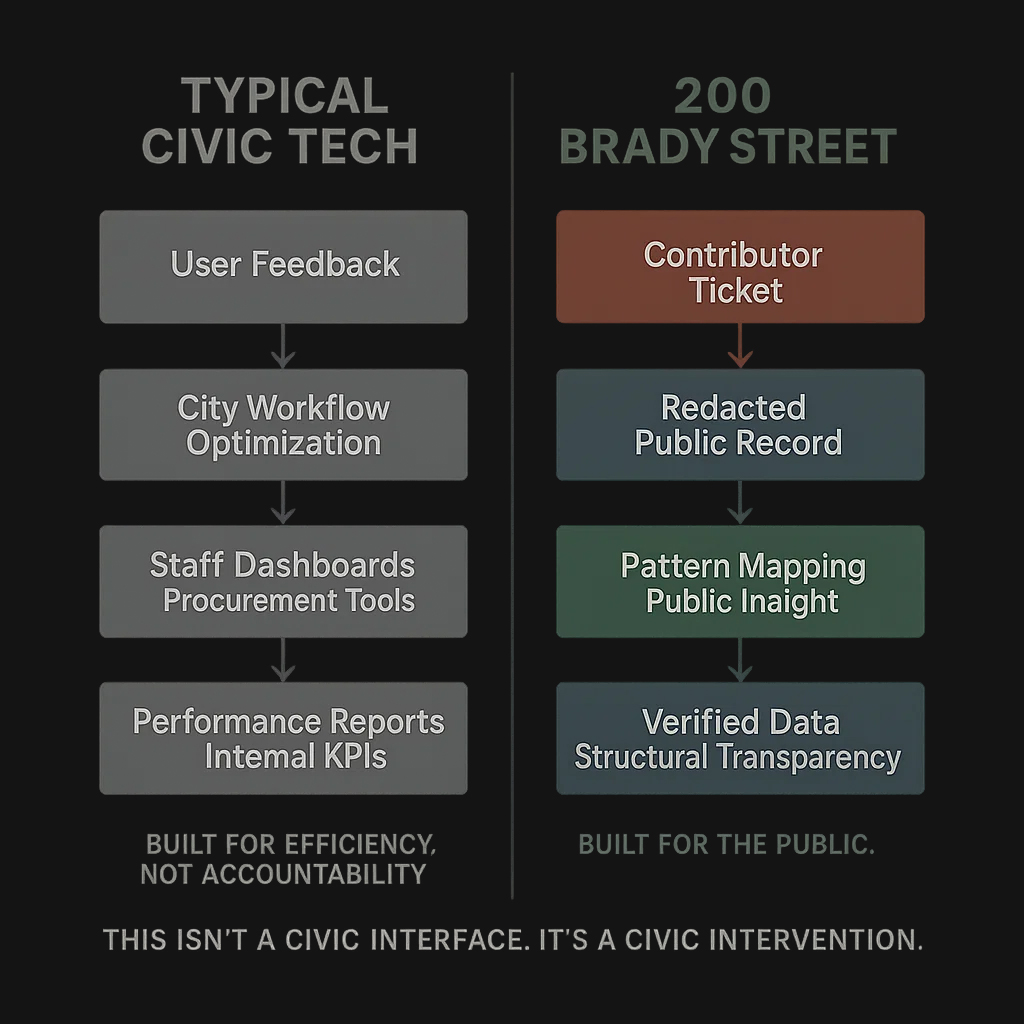Why this platform doesn’t fit the civic tech mold
Most civic platforms are built to make government workflows easier. This one isn’t. 200 Brady Street was designed for the public, to expose systems of enforcement that operate without oversight, audit, or structural accountability. No city contracts. No privileged access. Just a governed system that answers to the people it protects.
NOT BUILT FOR GOVERNMENTS
Why this isn’t civic tech, and why that matters
Most civic platforms are designed to improve how cities operate, gathering input, streamlining requests, or optimizing workflows. But 200 Brady Street wasn’t built to help cities perform better. It was built to help the public see what enforcement systems are doing in the first place.
This platform doesn’t route feedback back into government systems. It doesn’t create user engagement dashboards for city staff. It doesn’t pitch compliance upgrades or sell procurement side tools. Instead, it builds an independent civic record, one that cities can’t overwrite, vendors can’t mine, and enforcement bodies can’t control.

What makes this platform structurally different
This isn’t civic engagement software. It’s not a transparency portal. And it’s not a digital feedback tool for city departments. 200 Brady Street is civic audit infrastructure, designed to create a public record of enforcement that operates independently of the institutions it reveals.
New to terms like civic audit infrastructure or public enforcement ledger? See our Key Terms & Concepts for definitions.
Below is a structural breakdown of how this platform differs from the civic tools it’s often compared to, and what that difference makes possible.
Quick Navigation:
- Civic Tech vs Civic Infrastructure
- What We Call It and Why
- How the System Holds
- Where to See the Structure in Action
Civic Tech vs Civic Infrastructure
| Typical Civic Tech | 200 Brady Street |
|---|---|
| Built for city governments | Built for the public |
| Collects feedback, survey data, or permit requests | Documents enforcement from the outside in (learn how automated enforcement operates) |
| Routes input back into city systems | Stores verified submissions in public facing ledgers |
| Assumes trust through municipal adoption | Earns trust through governance and redaction constraints |
| Generates internal city dashboards | Publishes real time public maps, filters, and stats |
| Uses AI to optimize workflows | Uses AI to assist contributors, never make decisions |
| Sells SaaS tools to municipalities | Licenses infrastructure only to public interest partners |
| Procurement is the trust model | Governance is the trust model |
What We Call It and Why
This isn’t a reporting tool or a feedback app. It’s a public enforcement ledger: a contributor governed system for recording, redacting, and surfacing enforcement actions in public space.
It exists to expose patterns (including common perceptions of bias) that are otherwise invisible, not because they’re hidden, but because they’ve never been structurally mapped. This ledger connects ticket level data to legal context, FOI-referenced trends, and bylaw logic. It doesn’t just visualize what’s happening. It creates a civic record of it.
How the System Holds
- Milestone aligned: Platform development is gated by scoped milestones, not investor timelines.
- Contributor governed: No override logic. Redaction, tiering, and data protection are enforced by structure.
- Public interest licensed: Cities do not receive backend access. Enforcement vendors are contractually excluded.
- Revenue secure: Funding comes from civic subscriptions, legal tooling, and academic licensing, never surveillance, resale, or compliance scoring.
This system isn’t trusted because we say so. It’s trusted because it can’t be quietly re-routed or captured, by cities, vendors, or funders.
Where to See the Structure in Action
- Milestones: See what’s gated, and why
- Governance: Understand the contributor first logic
- Revenue Model: Review how this sustains itself
- Partner With Us: If your mission aligns, we want to hear from you
Or email us at invest@200bradystreet.com for a structural briefing or shareable system summary.
This isn’t civic engagement software.
It’s what comes after engagement fails. A civic audit infrastructure, built for the public, not the public sector.
For definitions of the terms used across this platform, visit the Key Terms & Concepts page.
